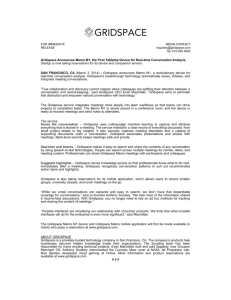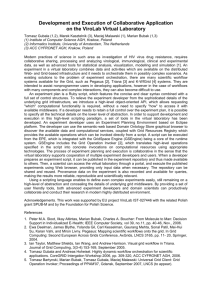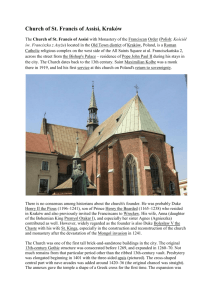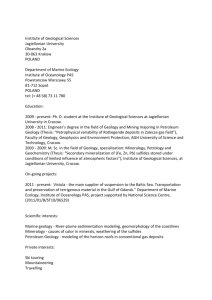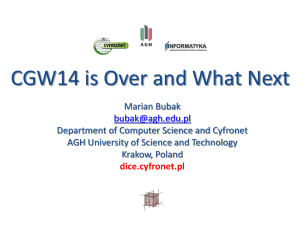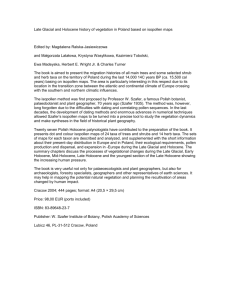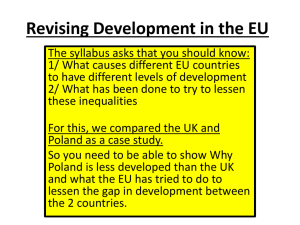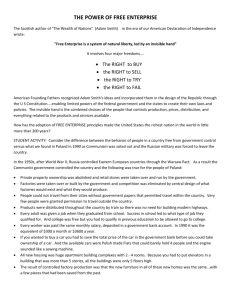GridSpace Virtual Laboratory - PL-Grid
advertisement
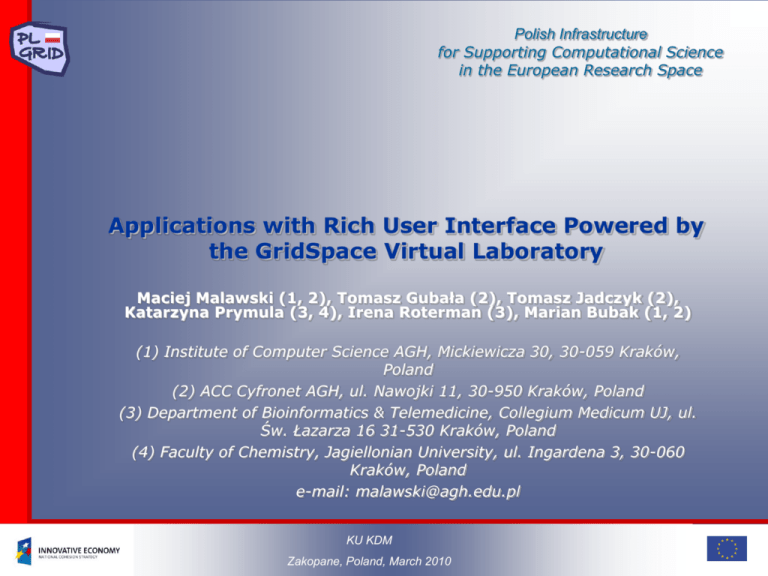
Polish Infrastructure for Supporting Computational Science in the European Research Space Applications with Rich User Interface Powered by the GridSpace Virtual Laboratory Maciej Malawski (1, 2), Tomasz Gubała (2), Tomasz Jadczyk (2), Katarzyna Prymula (3, 4), Irena Roterman (3), Marian Bubak (1, 2) (1) Institute of Computer Science AGH, Mickiewicza 30, 30-059 Kraków, Poland (2) ACC Cyfronet AGH, ul. Nawojki 11, 30-950 Kraków, Poland (3) Department of Bioinformatics & Telemedicine, Collegium Medicum UJ, ul. Św. Łazarza 16 31-530 Kraków, Poland (4) Faculty of Chemistry, Jagiellonian University, ul. Ingardena 3, 30-060 Kraków, Poland e-mail: malawski@agh.edu.pl KU KDM Zakopane, Poland, March 2010 Outline Overview of GridSpace Virtual Laboratory Flexibility of GridSpace platform Example Experiments: Patient History Display (ViroLab domain) Prediction of Ligand Binding Sites in Proteins Towards GridSpace 2.0 Demonstration References 2 GridSpace Virtual Laboratory GridSpace virtual laboratory integrates computational resources and relevant data to provide users with convenient, high-level tools for collaborative experiment planning and execution Users Interfaces Runtime Services Infrastructure Experiment developer Experiment Planning Environment Experiment scenario Scientist Portal End User Application Specific Portlet Virtual Laboratory runtime components (Required to select resources and execute experiment scenarios) Computational services (services (WS, WTS, WS-RF), components (MOCCA), jobs (EGEE, AHE)) Data services (DAS data sources, standalone databases) Grids, Clusters, Computers, Network 3 Application Lifecycle 4 User Interfaces of Virtual Laboratory Experiment Management Interface Portal GWT, AJAX Experiment Planning Environment Eclipse RPC 5 Patient History Display Experiment Experiment Management Interface (EMI) Main experimentation GUI Result Store Contains payloads and metadata about experiment results Data Access Secure, uniform access to multiple data sources GridSpace Engine Executes in-silico experiments Rich interface: Dynamically generated HTML/JavaScript page stored in Result Store Dynamically created PDF file 6 Prediction of Ligand Binding Sites in ViroLab Many services are publicly available, but only via WWW or email interface Automated in Virtual Laboratory using: HTTP communications wrapping Task queuing system for handling timeconsuming service invocations Conversion to a common format Generating Jmol visualization scripts Services available as gems in the Virtual Laboratory Rich interface: Dynamically uploaded JMol-based viewer Automatic update of application using Experiment Repository 7 Demo movies 8 Conclusions Flexibility and the features of the GridSpace platform: to rapidly develop scientific applications rich Web and graphical user interfaces Experiment developers have full access to rich capabilities of Ruby and its libraries Possible to develop applications in flexible and creative way: application repository – application versioning and updates result management – sharing and publishing results on the Web Extensibility allowed us to deliver applications despite changing and undefined requirements Scientific community (ViroLab) Business applications (GREDIA) 9 Towards GridSpace 2.0 Support for more scripting languages: Python Perl Web console for collaborative and interactive access to PL-Grid resources gLite and local PBS middleware support Simple access to remote files Sharing of gems, experiments and code snippets Semantic Integration framework as extension of Result Management facility 10 References P.M.A Sloot, Peter V. Coveney, G. Ertayalan, V. Mueller, C.A. Boucher, and M. Bubak: HIV decision Support: from Molecule to Man. Philosophical Transactions of the Royal Society A, vol 367, pp 2691 - 2703, 2009, doi:10.1098/rsta.2009.0043. M. Bubak, M. Malawski, T. Gubala, M. Kasztelnik, P. Nowakowski, D. Harezlak, T. Bartynski, J. Kocot, E. Ciepiela, W. Funika, D. Krol, B. Balis, M. Assel, and A. Tirado Ramos. Virtual laboratory for collaborative applications. In M. Cannataro, editor, Handbook of Research on Computational GridTechnologies for Life Sciences, Biomedicine and Healthcare, chapter XXVII, pages 531-551. IGI Global, 2009 M. Malawski, T. Bartyński, and M. Bubak. Invocation of operations from script-based grid applications. Future Gener. Comput. Syst., 26(1):138-146, 2010. T. Gubala, M. Bubak, P.M.A. Sloot; Semantic Integration of Collaborative Research Environments, In: M. Cannataro (Ed.) Handbook of Research on Computational Grid Technologies for Life Sciences, Biomedicine and Healthcare, Information Science Reference, 2009, IGI Global. Bryliński M, Prymula K, Jurkowski W, Kochańczyk M, Stawowczyk E, et al. 2007 Prediction of Functional Sites Based on the Fuzzy Oil Drop Model. PLoS Comput Biol 3(5): e94. doi:10.1371/journal.pcbi.0030094 Grid Space webpage http://gs.cyfronet.pl/ PL-Grid Project, http://www.plgrid.pl/en 11
